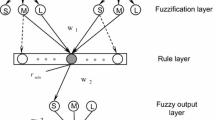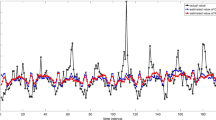Abstract
Travel time perception and learning play a central role in the modeling of day-to-day travel choice dynamics in traffic networks and have attracted the attention of many researchers, specifically for the analysis and operation of intelligent transportation systems and travel demand management scenarios. In this paper, a fuzzy learning model is proposed to capture the mechanism by which travelers update their travel time perceptions from one day to the next, taking into account their experienced travel times. To capture travelers’ mental representations of uncertain travel time involving imprecision and uncertainty, a combined artificial neural network and fuzzy logic (neuro-fuzzy) architecture called adaptive-network-based fuzzy inference system is employed. This framework, which utilizes a set of fuzzy if–then rules, can serve as a basis for modeling the qualitative sides of travelers’ knowledge and reasoning processes. From the output of this study, the results of our laboratory-like experiment provide a good fit to the stated data of travelers’ behavior, and may reflect the fact that the neuro-fuzzy approach can be considered a promising method in learning and perception updating models. Finally, the proposed learning model is embedded in a microscopic event-based simulation framework to evaluate its credibility within a day-to-day behavior of the traffic network. The results of the simulation, which converge to the equilibrium state of the test network, are finally presented, implying that the proposed perception updating model operates properly.









Similar content being viewed by others
References
Adeli H, Jiang X (2003) Neuro-fuzzy logic model for freeway work zone capacity estimation. J Transp Eng 129(5):484–493
Andrade K, Uchida K, Kagaya S (2006) Development of transport mode choice model by using adaptive neuro-fuzzy inference system. Transp Res Rec J Transp Res Board 1977:8–16
Arentze T, Timmermans H (2003) Modeling learning and adaptation processes in activity-travel choice A framework and numerical experiment. Transportation 30(1):37–62
Arnott R, de Palma A, Lindsey R (1993) A structural model of peak-period congestion: a traffic bottleneck with elastic demand. Am Econ Rev 83(1):161–179
Arslan T, Khisty J (2006) A rational approach to handling fuzzy perceptions in route choice. Eur J Oper Res 168(2):571–583
Avineri E, Prashker JN (2003) Sensitivity to uncertainty: Need for a paradigm shift. Transp Res Rec J Transp Res Board 1854(1):90–98
Ben-Akiva M, Lerman SR (1985) Discrete choice analysis: Theory and application to predict travel demand. The MIT Press, Cambridge, Massachusetts London, England
Bogers EA, Bierlaire M, Hoogendoorn SP (2007) Modeling learning in route choice. Transp Res Rec J Transp Res Board 2014:1–8
Bojadziev G, Bojadziev M (2007) Fuzzy logic for business, finance, and management. World Scientific Publishing Co. Pte. Ltd., Singapore
Bortolan G, Degani R (1985) A review of some methods for ranking fuzzy subsets. Fuzzy Sets Syst 15(1):1–19
Buragohain M, Mahanta C (2008) A novel approach for ANFIS modelling based on full factorial design. Appl Soft Comput 8(1):609–625
Cascetta E (1989) A stochastic process approach to the analysis of temporal dynamics in transportation networks. Transp Res Part B 23(1):1–17
Chen L-H, Lu H-W (2001) An approximate approach for ranking fuzzy numbers based on left and right dominance. Comput Math Appl 41(12):1589–1602
Chen R, Mahmassani H (2004) Travel time perception and learning mechanisms in traffic networks. Transp Res Rec J Transp Res Board 1894(1):209–221
Chen MS, Ying LC, Pan MC (2010) Forecasting tourist arrivals by using the adaptive network-based fuzzy inference system. Expert Syst Appl 37(2):1185–1191
de Palma A, Marchal F (2002) Real cases applications of the fully dynamic METROPOLIS tool-box: an advocacy for large-scale mesoscopic transportation systems. Netw Spat Econ 2(4):347–369
de Palma A, Ben-Akiva M, Brownstone D, Holt C, Magnac T, McFadden D, Moffatt P, Picard N, Train K, Wakker P (2008) Risk, uncertainty and discrete choice models. Mark Lett 19(3):269–285
Dell’Orco M, Ottomanelli M (2012) Simulation of users decision in transport mode choice using neuro-fuzzy approach. In: Murgante B, Gervasi O, Misra S et al (eds) Computational science and its applications. Lecture Notes in Computer Science, Springer, pp 44–53
Dell’Orco M, Teodorovic D (2009) Data fusion for updating information in modelling drivers’ choice behaviour. Transportmetrica 5(2):107–123
Ettema D, Timmermans H, Arentze T (2004) Modelling perception updating of travel times in the context of departure time choice under ITS. J Intel Transp Syst 8(1):33–43
Ettema D, Tamminga G, Timmermans H, Arentze T (2005) A micro-simulation model system of departure time using a perception updating model under travel time uncertainty. Transp Res Part A 39(4):325–344
Fujii S, Kitamura R (2004) Drivers’ mental representation of travel time and departure time choice in uncertain traffic network conditions. Netw Spat Econ 4(3):243–256
Fuzzy Logic Toolbox User’s Guide (2010) The Math Works Inc., 3 Apple Hill Drive Natick, MA 01760-2098, USA
Hawas YE (2004) Development and calibration of route choice utility models: neuro-fuzzy approach. J Transp Eng 130(2):171–182
He X, Guo X, Liu H (2010) A link-based day-to-day traffic assignment model. Transp Res Part B 44(4):597–608
Henn V (2005) What is the meaning of fuzzy costs in fuzzy traffic assignment models? Transp Res Part C 13(2):107–119
Henn V, Ottomanelli M (2006) Handling uncertainty in route choice models: from probabilistic to possibilistic approaches. Eur J Oper Res 175(3):1526–1538
Horowitz JL (1984) The stability of stochastic equilibrium in a two-link transportation network. Transp Res Part B 18(1):13–28
Iida Y, Akiyama T, Uchida T (1992) Experimental analysis of dynamic route choice behavior. Transp Res Part B 26(1):17–32
Jang J (1993) ANFIS: adaptive-network-based fuzzy inference system. IEEE Trans Syst Man cybern 23(3):665–685
Jha M, Madanat S, Peeta S (1998) Perception updating and day-to-day travel choice dynamics in traffic networks with information provision. Transp Res Part C 6(3):189–212
Jotisankasa A, Polak JW (2006) Framework for travel time learning and behavioral adaptation in route and departure time choice. Transp Res Rec J Transp Res Board 1985(1):231–240
Karayiannis NB, Venetsanopoulos AN (1993) Artificial neural networks: learning algorithms, performance evaluation, and applications. Kluwer Academic Publishers Group, The Netherlands
Khademi N, Mohaymany AS, Shahi J (2010) Intelligent transportation system user service selection and prioritization. Transp Res Rec J Transp Res Board 2189(1):45–55
Khademi N, Bahaabadi MR, Mohaymany AS, Shahi J (2013) Deriving fuzzy inequalities using discrete approximation of fuzzy numbers. Int J Ind Eng 24(3):207–216
Kim H, Lim Y (2012) A day-to-day route choice model based on drivers’ past experience. KSCE J Civ Eng 16(7):1267–1279
Leondes CT (1999) Fuzzy theory systems: techniques and applications, vol 1. Academic Press, London
Mahmassani HS, Chang G-L (1986) Experiments with departure time choice dynamics of urban commuters. Transp Res Part B 20(4):297–320
Miller GA (1956) The magical number seven, plus or minus two: some limits on our capacity for processing information. Psychol Rev 63(2):81–97
Miller GA (2003) The magical number seven, plus or minus two: Some limits on our capacity for processing information. In: Banks WP, Newman JB, Baars BJ (eds) Essential sources in the scientific study of consciousness. The MIT Press, Cambridge, pp 352–372
Mucsi K, Khan AM, Ahmadi M (2011) An adaptive neuro-fuzzy inference system for estimating the number of vehicles for queue management at signalized intersections. Transp Res Part C 19(6):1033–1047
Murat Y (2006) Comparison of fuzzy logic and artificial neural networks approaches in vehicle delay modeling. Transp Res Part C 14(5):316–334
Nakayama S, Kitamura R (2000) Route choice model with inductive learning. Transp Res Rec J Transp Res Board 1725(1):63–70
Nakayama S, Kitamura R, Fujii S (1999) Drivers’ learning and network behavior: dynamic analysis of the driver-network system as a complex system. Transp Res Rec J Transp Res Board 1676(1):30–36
Nakayama S, Kitamura R, Fujii S (2001) Drivers’ route choice rules and network behavior: do drivers become rational and homogeneous through learning? Transp Res Rec J Transp Res Board 1752(1):62–68
Nguyen HT, Prasad NR, Walker CL, Walker EA (2003) A first course in fuzzy and neural control. Chapman & Hall/CRC, Boca Raton, Florida
Oh J-S, Cortés CE, Recker W (2003) Effects of less-equilibrated data on travel choice model estimation. Transp Res Rec J Transp Res Board 1831(1):131–140
Ottomanelli M, Caggiani L, Iannucci G, Sassanelli D (2010) An adaptive neuro-fuzzy inference system for simulation of pedestrians behaviour at unsignalized roadway crossings. In: Gao X, Gaspar-Cunha A, Köppen M, Schaefer G, Wang J (eds) Soft computing in industrial applications, vol 75, Advances in intelligent and soft computing. Springer, Berlin, pp 255–262
Ozbay K, Datta A, Kachroo P (2001) Modeling route choice behavior with stochastic learning automata. Transp Res Rec J Transp Res Board 1752(1):38–46
Pang GKH, Takabashi K, Yokota T, Takenaga H (1999) Adaptive route selection for dynamic route guidance system based on fuzzy-neural approaches. IEEE Trans Veh Technol 48(6):2028–2041
Postorino M, Versaci M (2008) A neuro-fuzzy approach to simulate the user mode choice behaviour in a travel decision framework. Int J Model Simul 28(1):64
Prashker JN, Bekhor S (2004) Route choice models used in the stochastic user equilibrium problem: a review. Transp Rev 24(4):437–463
Pribyl O, Goulias KG (2003) Application of adaptive neuro-fuzzy inference system to analysis of travel behavior. Transp Res Rec 1854:180–188
Rubinstein RY, Kroese DP (2011) Simulation and the Monte Carlo method, 2nd edn. Wiley, Hoboken, New Jersey
Saaty TL, Ozdemir MS (2003) Why the magic number seven plus or minus two. Math Comput Model 38(3–4):233–244
Sayed T, Tavakolie A, Razavi A (2003) Comparison of adaptive network based fuzzy inference systems and b-spline neuro-fuzzy mode choice models. J Comput Civ Eng 17(2):123–130
Seyedabrishami S, Shafahi Y (2011) Expert knowledge-guided travel demand estimation: neuro-fuzzy approach. J Intel Transp Syst 15(1):13–27
Shoorehdeli MA, Teshnehlab M, Sedigh AK (2009) Training ANFIS as an identifier with intelligent hybrid stable learning algorithm based on particle swarm optimization and extended Kalman filter. Fuzzy Sets Syst 160(7):922–948
Takagi T, Sugeno M (1983) Derivation of fuzzy control rules from human operator’s control actions. Proceeding of the IFAC Symposium on Fuzzy Information, Marseille, pp. 55–60
Teodorovic D (1994) Fuzzy sets theory applications in traffic and transportation. Eur J Oper Res 74(3):379–390
Teodorovic D (1999) Fuzzy logic systems for transportation engineering: the state of the art. Transp Res Part A 33(5):337–364
Train K (2009) Discrete choice methods with simulation. Cambridge University Press, UK
Wang R, Zhang J, Zhang Y, Wang X (2012) Assessment of human operator functional state using a novel differential evolution optimization based adaptive fuzzy model. Biomed Signal Process Control 7(5):490–498
Yager RR, Zadeh LA (1994) Fuzzy sets, neural networks and soft computing. John Wiley & Sons, Inc
Yanmaz-Tuzel O, Ozbay K (2009) Modeling learning impacts on day-to-day travel choice. In: Lam WHK, Wong SC, Lo HK (eds) Transportation and traffic theory 2009: Golden Jubilee. Springer, US, pp 387–401
Zadeh LA (1965) Fuzzy sets. Inf Control 8(3):338–353
Zanaganeh M, Mousavi SJ, Etemad Shahidi AF (2009) A hybrid genetic algorithm–adaptive network-based fuzzy inference system in prediction of wave parameters. Eng Appl Artif Intel 22(8):1194–1202
Zerguini S, Khademi N, Shahi J (2011) Variability of travel time, users’ uncertainty, and trip information. Transp Res Rec J Transp Res Board 2254(1):160–169
Acknowledgments
The authors would like to convey their deep appreciation to the anonymous referees for their valuable comments that considerably improved the overall quality of this paper.
Author information
Authors and Affiliations
Corresponding author
Rights and permissions
About this article
Cite this article
Khademi, N., Rajabi, M., Mohaymany, A.S. et al. Day-to-day travel time perception modeling using an adaptive-network-based fuzzy inference system (ANFIS). EURO J Transp Logist 5, 25–52 (2016). https://doi.org/10.1007/s13676-014-0047-3
Received:
Accepted:
Published:
Issue Date:
DOI: https://doi.org/10.1007/s13676-014-0047-3
Keywords
- Fuzzy inference
- Artificial neural networks
- Day-to-day dynamics
- Driver behavior
- Drivers’ perception updating
- Drivers’ learning




